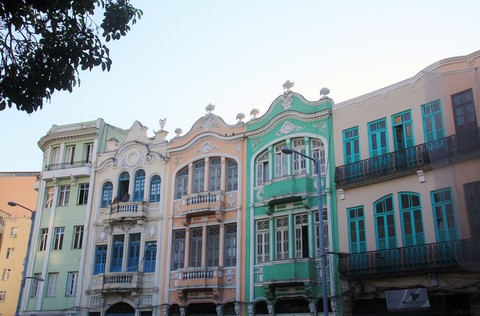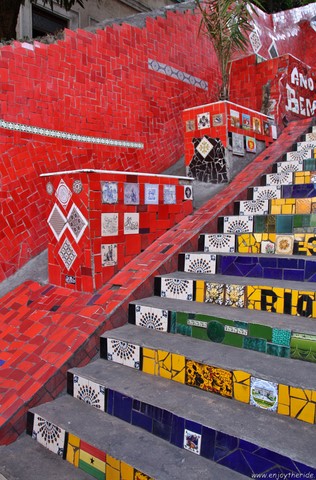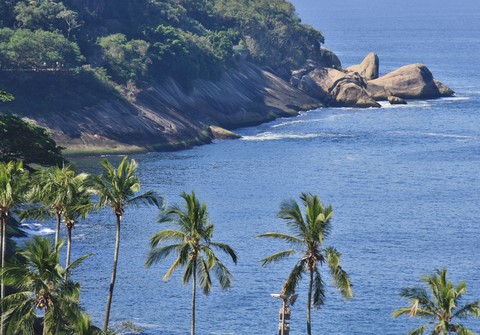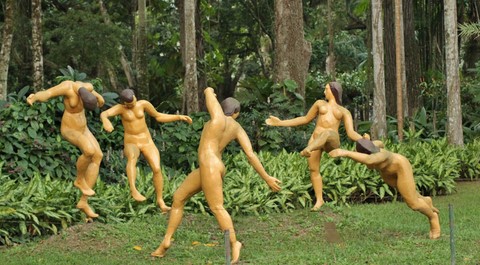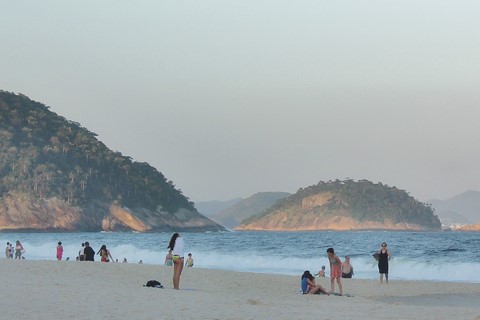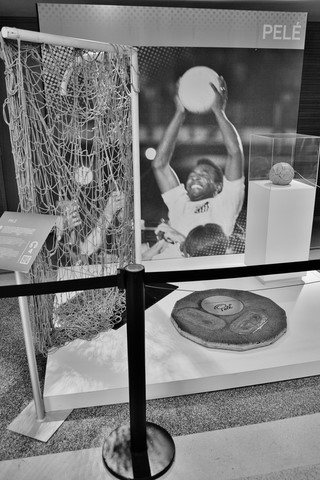Rio de Janeiro
You can click on pictures to enlarge them
The cidade maravilhosa is obviously a must-visit. Its richness and its diversity is undeniable, and it enjoys beautiful historic and geographic sites. Its carnival is famous all around the world. Buildings mix with ocean, forests, mountains and morros (among which the best known is the Sugar Loaf) to blend into a background that is unique in the world, the whole rocked by a tropical climate. It succeeded Salvador de Bahía as the capital of Brazil before it is replaced by Brasilia in 1960. Nevertheless, it is and it will remain the most famous and appreciated city in the country. French culture has been rooted there since the 19th century, and some buildings are inspired from the ones in Paris. Besides, you will be surprised by the Brazilians' craze for the French capital, especially in Rio.
Unfortunately, favelas are numerous, but a process of pacification started lately. Even though they are conscious it is a long-term task, the examples of success in Santa Marta and Vidigal, among others, allow to hold out the hope. Generally, most of districts have a strong identity. However, only the ones in the South area and the Center area are attractive for visitors. In the North area, still plagued by violence, the Maracanã Stadium and Quinta da Boa Vista are the only points of interest.
Centro
It includes most of historic and cultural buildings. The French influence mentioned in introduction is visible notably on the famous Colombo cake shop, in Art Nouveau style, and the Teatro Municipal. Indeed, the latter was built on the model of the Opéra Garnier in the beginning of the 20th century, like the one in São Paulo. It houses the Opera and the Philharmonic Orchestra of Rio. Streets – some of which are very lively and filled with music – show colored Colonial façades that are faded and eroded by the wear and tear of time, but it gives them and old-fashioned charm and an undeniable authenticity. Praça da Republica – or Campo Santana – is a haven of greenery very wooded and adorned with small ponds.
Be aware that it is better to visit that district during the week and before nightfall. Outside those hours, it can be dangerous especially in deserted areas. However, even in broad daylight, we have been approached by locals who advised us with a lot of benevolence to pack away our cameras, which led to that frustration mentioned in the very beginning of this section. We decided to keep them anyway because we were keen on capturing some buildings. We have not the opportunity to visit the cidade maravilhosa every day! We took care of staying close to one another and not getting far from lively areas. Nevertheless, our pleasure was lightly spoiled. As a result, we did not linger in that district during our journey in Rio. We just stayed and sometimes ate there.
Lapa and Santa Teresa
The old district of Lapa is really authentic, and it is amazing and regrettable that visitors do not linger there. The iconic Arcos da Lapa, stunning aqueduct of the 18th century which supplied the city with water from the Carioca River, was converted by the end of the 18th century into a railway for the famous yellow tramway of Santa Teresa. At the feet of arches, musicians often come and perform, which gives the place a bohemian atmosphere. Nightlife is rocked by samba, and the district is surprisingly safe at night, which contrasts with the rest of the city. You just got to stay close to the shows.
Nearby, the amazing Catedral Metropolitana imposes its truncated pyramid shaped outlines, inspired from Maya temples in the Mexican Yucatan. Its dimensions are impressive and it has a capacity of up to 20 000 people. Inside, stained glass windows stretch to many tens of meters high.
As we entered a little more the streets of the district, we made a stop in the Hospital Ordem Terceira Do Carmo, which sumptuous patio with façades in Baroque style amazed us. In its middle stands a beautiful fountain.
The Escadaria Selarón (photo), listed as a Historic Monument, links Lapa to Santa Teresa District. Those stairs were named after the Chilean artist Jorge Selarón, who covered them with multicolored azulejos for years, with a mind-blowing result. That colossal project dedicated to the Brazilian people drew such an enthusiasm abroad that he has been sent glazed tiles from all around the world. For the last years, he set out to paint them himself showing his famous pregnant woman featured in his artworks. According to us, that site deserves to be part of the must-visits in Rio in the same way as the Sugar Loaf or Christ the Redeemer of the Corcovado.
Santa Teresa, bohemian district on a hillside with nice bourgeois houses, was temporarily abandoned to rise from the ashes nowadays. Locals and tourist mingle there. With its mound, that place makes you think of a Brazilian Montmartre. Parque das Ruinas offers a unique view of Guanabara Bay and the Sugar Loaf.
Flamengo, Botafogo and Urca
Flamengo and Botafogo are residential districts that also offer a unique view of Guanabara Bay and the Sugar Loaf. Their beaches are beautiful but unfit for swimming because they are polluted. That is the reason why they are neglected in favor of the famous beaches of Copacabana and Ipanema. Nevertheless, they are quite pleasant: Parque do Flamengo, on the seafront, is ideal for walks and sports activities. Football fields are numerous and games take place almost continuously. Bars and restaurants are very varied. Moreover, they are ideally located between the Center and the Southern area and their numerous attractions.
Located on a peninsula, Urca district is also neglected by tourists. Yet, it is an authentic small village with its fishing port, very quiet and safe (it is located in a military area). Low houses from the early 20th century stand along its small streets full of charm. The Neo-Classical architecture dominates in its main roads. Between the Sugar Loaf and the Morro do Urubu is located Praia Vermelha, small red sand beach in the heart of charcoal cliffs where rowboats float peacefully, rocked by the slow movement of water. It is also the starting point of the Claudio Coutinho track, which runs along the rocky coast over 2.5 kilometers in the heart of a lush greenery. It leads to the path which climbs to the Morro de Urca, where the first of the two cableways which provide the ascent to the Sugar Loaf stops. There we met micos, lovely little monkeys who populate the place.
The Sugar Loaf (Pão de Açúcar) is – with Christ the Redeemer – the idealized image of Rio. Its two step ascent is impressive. First, a cableway takes you to the Morro de Urca, and then another one leads you to your destination at the cost of a dizzying climb over the void. Thrills are guaranteed! Once you are on top, you find yourself almost 400 meters high to be impressed by a 360 degree panoramic view. Guanabara Bay is offered to you, with its numerous beaches. The Maracanã Stadium yet far seems within reach. In the distance, you can see the Corcovado and Christ the Redeemer.
Nevertheless, you should not neglect the Morro de Urca, which has a performing area and a restaurant. The place is pleasant, the view is beautiful, and it is worth lingering there. That is what we did, and we had the very nice surprise to meet closely many micos that were not wild at all. We fed them with berries picked on trees, which are part of their usual food. They took them from our hands to bring them to their mouth and enjoy them. An unforgettable experience!
Christ the Redeemer and Botanical Garden
Perched on the Corcovado Peak, the statue of Christ the Redeemer (Cristo Redentor), classified in the Historical Heritage, has impressive dimensions. It can be reached by car, or by a train which enters the lush vegetation of the Tijuca Forest overcoming a 3800 meters altitude difference. Besides, part of the price of the admission ticket is dedicated to its preservation. 31 meters high, with a 27 meters wingspan from one hand to another and perched on an 8 meters pedestal, you contemplate it with admiration turning your neck backwards, the more as the panoramic viewpoint all around is not very spacious. Honestly, that site attracted us less than the Sugar Loaf where we stayed for hours. As a result, we lingered there less. The 360 degree panoramic view there is as much breathtaking, but the crowd is often huge, and you get quickly stuck in a narrow space around the colossal statue. It is very hard to take pictures in good conditions. You can fall back upon terraces where stand bars, restaurants and souvenir shops, which will allow you a little bit to get far from the bustle. Nevertheless, we enjoyed visiting that must-see that is famous all around the world, and felt the satisfaction to find ourselves in a mythical place.
The Botanical Garden (Jardim Botânico) (photo), which dates from the early 19th century, has more than 6000 tropical species from all around the world. It is supplied with water from the Tijuca Forest by two watercourses. You disconnect completely from town to feel very close to nature. The long row on palm trees from Malaysia – from where you can see the Corcovado – is stunning. Generally, we have been amazed by the size of the biggest trees, and by their force and their solidity as well. A central lake is partially covered by huge water lilies. The various sculptures and fountains come from the Centro. A glass roof houses carnivorous plants, another houses an abundance of cactus. You can also find some remains of the Atlantic Forest and a part of the sugar cane plantation which dates from the Colonial times.
The beaches
The mythical Copacabana Bay (photo) extends over nearly 4 kilometers from Leme beach (North) to Ipanema beach (South). The crowd is large and varied and the area lives 24 hours a day. There are any kind of entertainment, especially mini-concerts and sumptuous sand sculptures. Admittedly, you could feel nostalgic about the time when the seafront was not marred by modern buildings and gave a lot of space to Art Deco buildings. But the magic remained intact, as if it was unwavering in spite of the invasive modernity display. And it is enough to turn towards the ocean and admire the picture-postcard perfect - in the middle of which the Sugar Loaf imposes - to escape completely. Numbered lifeguard posts can also be used as landmarks. Pavements of the promenade are covered by alternating with black and white tiles which take the shape of waves. An artwork we owe to Roberto Burle Marx. There is a real culture of sport: beach-volley, beach-soccer, beach-tennis... Many have a high level: girls and boys alike, old and young alike.
Further South, Ipanema and Leblon are the upscale districts of Rio. Obviously, life is more expensive. Trendy bars and restaurants abound. Beaches enjoy a light breeze which makes the temperature milder. Ipanema beach, which vibrates to the rhythm of salsa, extends over 2 kilometers. People come to admire beautiful sunsets near lifeguard post 9, with generous applause at the end. It is extended with Leblon beach. The two are separated by the channel which links the Lagoa Rodrigo de Freitas to the Atlantic Ocean.
The Maracanã Stadium
Football in Brazil is a religion, it is well known. Passion there is disproportionate, and it is an integral part of the culture of the country. The mythical Maracanã Stadium is a genuine temple and it has a rich history. It is home to the Flamengo team, rival of Fluminense. The entertainment is as much in the stands as on the ground. The record attendance dates from 1970 and amounts to 200 000 spectators! Since then, it was renovated for the 2014 World Cup, and now it only contains 76000 spectators according to safety standards.
We started the visit with the press box on the 5th floor, then the VIP seats on the 3rd floor, and then the 1st floor where we were really close to the ground. We ended with the benches, the changing rooms and the press area. However, we were not allowed to step out onto the field.
We told ourselves it was a pity not to see it before its renovation which may have made it lose part of its cachet. But let us not be fussy about it: we had the pleasure and the privilege of visiting that historical arena. And above it all, the myth is still palpable. With a little bit of imagination, we can see again plays rooted in history, hear again shouts of joy and clamors, feel the passion, the fervor, the vibrations. Many famous names come to our minds, but we obviously think about King Pelé first and foremost, such a mythical player that his missed goals are as famous as the ones he scored, and are still on diverse TV reports and retrospectives.
Published on April, 27th 2016



